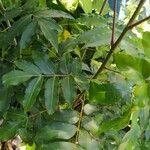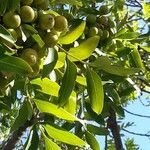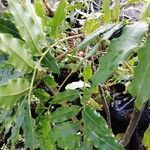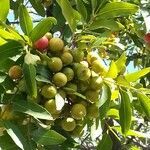Evergreen or semi-evergreen tree up to 20 m tall, often with a wide, umbrageous crown. Leaflets (7)9-13, lanceolate to oblong-lanceolate, up to 145 x 60 mm, tapering to an acuminate, subacuminate or, rarely, acute apex, base asymmetric; lower surface glabrous to tomentose. Inflorescence 70-250 mm long. Flowers white or pinkish white. Calyx 2 mm long, sparsely to densely puberulous. Petals 4-5 mm long, elliptic-oblong, densely puberulous on both surfaces. Staminal tube 2 mm long, puberulous outside, densely bearded at the throat inside. Ovary 15 x 2-2.5 mm, densely setulose; style 0.5 mm long. Drupe deep red, 18 x 15 mm, with (1)2-4(5) pyrenes.
Evergreen or semi-evergreen tree, 2-18 m high; wide canopy; dioecious. Leaves imparipinnate; leaflets ± lanceolate, entire, apex acuminate, base asymmetric. Flowers unisexual; in axillary panicles up to 250 mm long; white or pinkish white. Calyx saucer-shaped, puberulous. Petals elliptic-oblong, densely puberulous on both surfaces. Disc annular. Staminal tube basin-shaped, with 10 sessile anthers at apex of tube. Ovary sessile; style short and thick; stigma obscurely 4-or 5-lobed. Fruit a dry, globose, deep red drupe, 18 x 15 mm, with 2-4 pyrenes. Seeds mostly 1 per locule, exarillate.
A tall tree. The leaves are densely clustered. The leaves have up to 6 pairs of leaflets. They are opposite with a leaflet at the end. The leaflets are broadly sword shaped. They narrow to the tip. They are 8 cm long by 2.5 cm wide. The flowering shoots are in the axils of leaves. They are 12 cm long and branched. The flowers are greenish-white. The fruit is slightly fleshy and pink. They are round and 1 cm across.
Leaves imparipinnate, usually entirely glabrous, sometimes pubescent, rarely tomentose; petiole and rhachis up to 35 cm. long; leaflets up to 14·5 × 6 cm., usually much smaller, opposite or subopposite, 3–5 (6)-jugate, subsessile or shortly petiolulate, lanceolate to oblong-lanceolate, tapering to an acuminate or subacuminate apex, base asymmetric, lower surface never drying whitish.
Medium-sized evergreen or semi-evergreen tree up to 30 m. tall but usually less; bole slightly buttressed or fluted at base, up to 1 m. d.b.h.; second-year branchlets slender, usually less than 0·6 cm. diameter, smooth, with scattered leaf-scars, closely lenticellate with large whitish lenticels.
Evergreen or semi-evergreen tree, up to 20 m high. Leaf rhachis not winged or very narrowly winged; leaflets 9-13, lanceolate to oblong-lanceolate, up to 145 x 60 mm. Drupe with 2-4 pyrenes. Flowers white or pinkish white.
Dioecious tree to 20 m. Leaves opposite, imparipinnate, leaflets lanceolate, asymmetric at base. Flowers in axillary, cymose panicles, whitish.
Ovary 1·5 × 2 mm., densely setulose, style 0·5–1 mm. long, Drupe about 1·5 × 1·5 cm., bright red or (?) black, with 2–4 pyrenes.
Flowers dioecious, white or pinkish-white, sweet-scented, borne in many-flowered cymose panicles.
Staminal tube 2 mm. long, puberulous outside, densely bearded at throat inside.
Petals 4–5 mm. long, elliptic-oblong, densely puberulous on both surfaces.
Calyx 2 mm. long, sparsely to densely puberulous.





